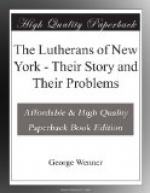“Also they teach, that One holy Church is to continue forever. The Church is the congregation of saints, in which the Gospel is rightly taught and the Sacraments rightly administered. And to the true unity of the Church, it is enough to agree concerning the doctrine of the Gospel and the administration of the Sacraments.”
This was the Lutheran position as against Rome.
But properly to understand our history we must also take account of another movement with which our churches had to contend at the same time that they were making their protest against Rome. This was a more radical form of Protestantism which found its expression among what are known as the Reformed Churches. It had its home in Switzerland, and made its way along the Rhine to Germany, France and Holland. Through John Knox it came to Scotland, and subsequently superseded Lutheranism in Holland and in England. It was from these countries that the earliest colonists came to America, and thus American Christianity early received the impress of the Reformed system. The few and scattered Lutheran churches which were established here in the early history of our country were brought into contact with a form of Protestantism at variance with their own theological principles. The history of our Church in America must be studied with this fact in mind, otherwise many of its developments will not be understood.
It would lead too far to explain the historical and philosophical differences between these two forms of Protestantism. A phrase first used by Julius Stahl aptly describes the difference. The Lutheran Reformation was the “Conservative Reformation.” Its general principle was to maintain the historical continuity of the Church, rejecting only that which was contrary to the word of God. The irenic character of the Augsburg Confession was owing to this principle. The Reformed Churches, on the other hand, made a tabula rasa of history, and, ignoring even the legitimate contributions of the Christian centuries, professed to return to apostolical simplicity, and to accept for their church-life only that which was explicitly prescribed by the Holy Scriptures.
Thus the Lutherans retained the churches as they were, with their altars and their pictures, the Liturgy and other products of art and of history, provided they were not contrary to the word of God. The Reformed, on the other hand, would have none of these things because they were not prescribed in the Bible. They worshipped in churches with bare walls, and dispensed with organs and music, in the interest of a return to Scriptural simplicity.
There were other differences, but these indicate the general character of the two movements.
History thus placed our Church between two fires, and the training she received explains in part the polemical character for which she has been distinguished. Sharp theological distinctions had to be made. The emphasis which she was compelled to place upon distinctive doctrine as a bond of fellowship accounts for the maintenance of standards which were not required in the early history of our Church when the seventh article of the Augustana was presented.




